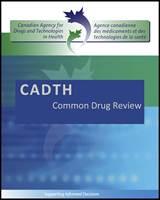Except where otherwise noted, this work is distributed under the terms of a Creative Commons Attribution-NonCommercial-NoDerivatives 4.0 International licence (CC BY-NC-ND), a copy of which is available at http://creativecommons.org/licenses/by-nc-nd/4.0/
NCBI Bookshelf. A service of the National Library of Medicine, National Institutes of Health.
Edoxaban (Lixiana) [Internet]. Ottawa (ON): Canadian Agency for Drugs and Technologies in Health; 2017 Apr.
The manufacturer submitted a cost-utility analysis conducted from the perspective of a Canadian health care payer with a lifetime horizon.
Although the purported objective was to assess the cost-effectiveness of edoxaban compared with other approved therapies in Canada for stroke prevention in patients with atrial fibrillation (AF), only the analyses comparing edoxaban 60 mg once daily with rivaroxaban 20 mg once daily and warfarin 5 mg once daily were presented in detail. Comparisons with dabigatran 110 mg twice daily and 150 mg twice daily and with apixaban 5 mg twice daily were presented only as secondary analyses. According to the submission’s authors, the focus on the comparison with rivaroxaban was justified for two reasons: rivaroxaban is the most commonly prescribed new oral anticoagulant (NOAC) in Canada, and the ROCKET-AF trial had a similar design to ENGAGE AF-TIMI 48.8,13
The model adopted was a Markov model constructed in Microsoft Excel. The model had a cycle length of one month and incorporated 18 health states — stable AF, mild ischemic stroke (IS), moderate IS, severe IS, post–mild IS, post–moderate IS, post–severe IS, mild hemorrhagic stroke (HS), moderate HS, severe HS, post–mild HS, post–moderate HS, post–severe HS, systemic embolic event (SEE), post-SEE, acute myocardial infarction (MI), post-MI, and death — and four transient events (other intracranial hemorrhage, transient ischemic attack, non–intracranial hemorrhage major bleed, and clinically relevant non-major bleed). Health states relating to events (IS, HS, SEE, and MI) were associated with increased costs, utility decrements, and mortality. In post-event health states, patients experienced increased health care costs, reduced utility, and increased risk of subsequent events. For transient events, patients experienced one-off costs and utility loss.
All patients are assumed to be in the stable AF state at model onset. The cohort then moves within the states in accordance with the underlying probability of events on edoxaban and the relative effects for both warfarin and the NOACs. Edoxaban monthly transition probabilities were derived from the ENGAGE AF-TIMI 48 trial.8 For warfarin, the hazard ratios from the ENGAGE AF-TIMI 48 trial were applied to the edoxaban transition probabilities.8 For other NOACs, a network meta-analysis was conducted to derive relative risks compared with edoxaban, which were then used to derive transition probabilities for patients treated with the other NOACs.1
Costs are presented in 2015 Canadian dollars and include treatment costs, event costs, and post-event costs. Drug costs were obtained from the Ontario Drug Benefit formulary, with warfarin management costs derived from a recent Canadian study.2,14 Acute event costs and post-event costs were derived from administrative data (Canadian Institute of Health Information) or published Canadian literature.3–7 The utility value for the stable AF state was derived from the ENGAGE AF-TIMI 48 trial.1–9 Utility values for events, utility decrements for transient events, and utility values for post-event states were derived from the published literature.10–12
All data sources and data values were similar to the recent CADTH Therapeutic Review of NOACs.15 Appropriate probabilistic sensitivity analysis and a vast array of deterministic sensitivity analyses were conducted.
- SUMMARY OF THE MANUFACTURER’S PHARMACOECONOMIC SUBMISSION - Edoxaban (Lixiana)SUMMARY OF THE MANUFACTURER’S PHARMACOECONOMIC SUBMISSION - Edoxaban (Lixiana)
- REFERENCES - Ingenol Mebutate (Picato)REFERENCES - Ingenol Mebutate (Picato)
Your browsing activity is empty.
Activity recording is turned off.
See more...
